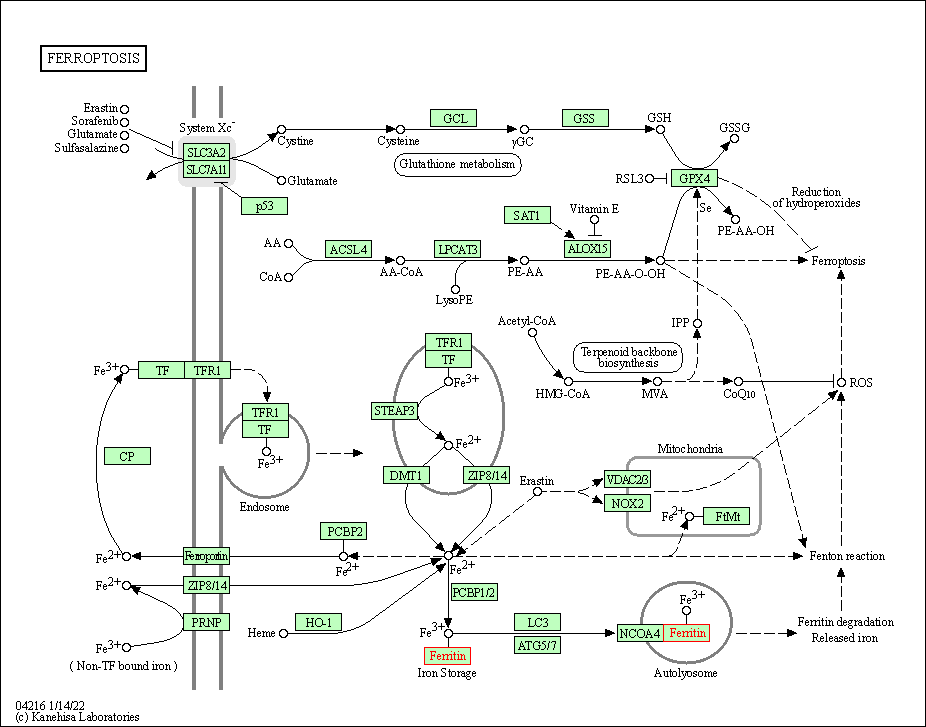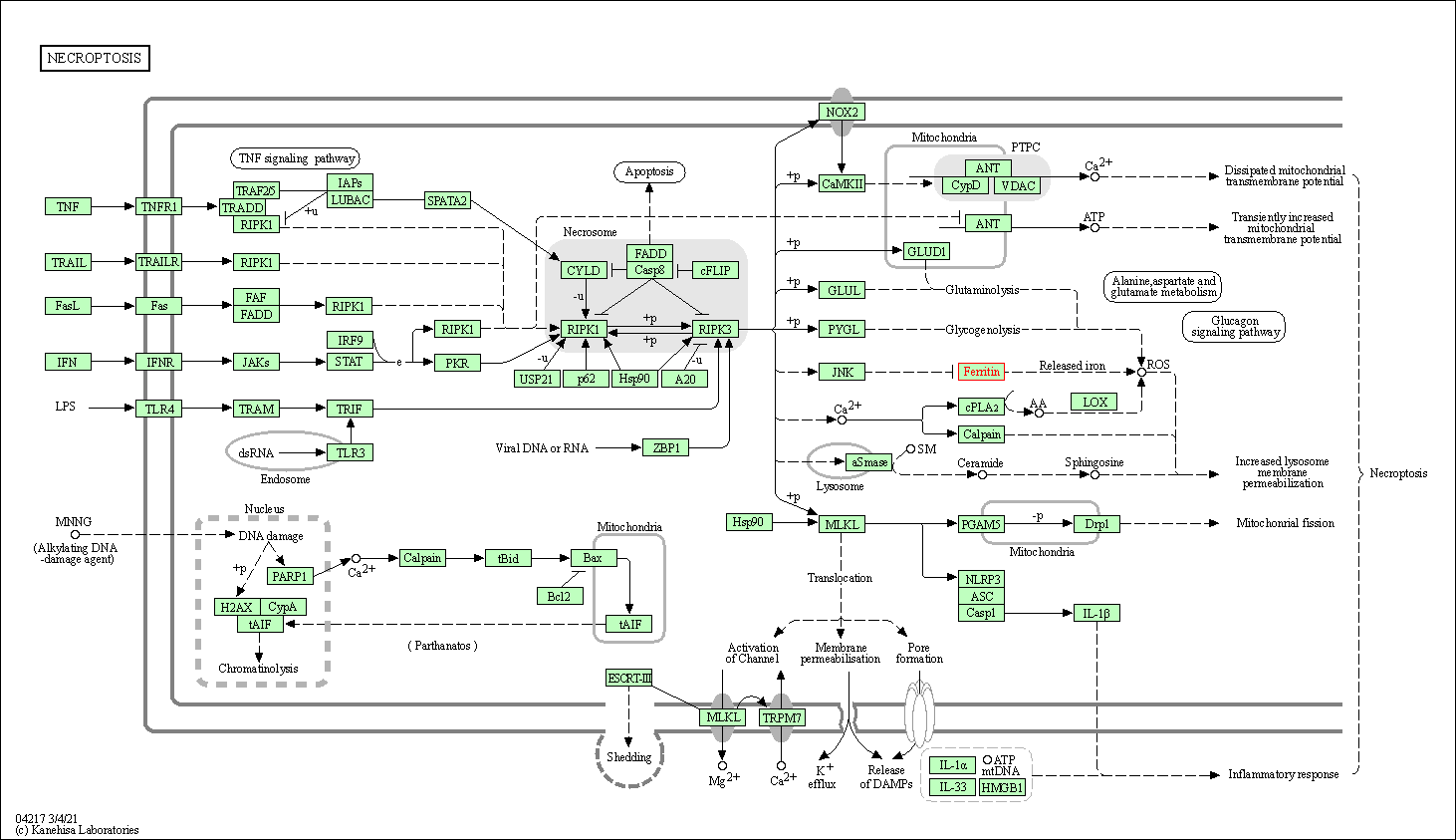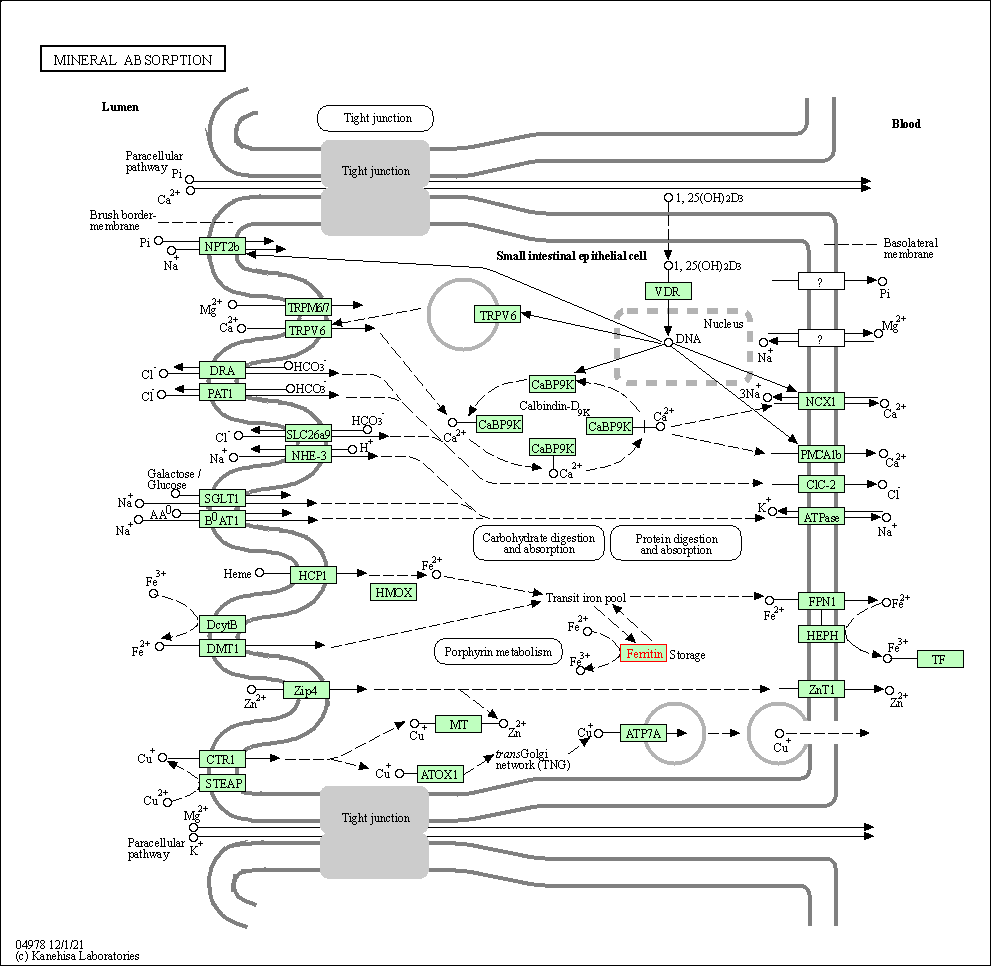Target Information
| Target General Information | Top | |||||
|---|---|---|---|---|---|---|
| Target ID |
T89873
(Former ID: TTDR01293)
|
|||||
| Target Name |
Ferritin (FTH1)
|
|||||
| Synonyms |
PIG15; OK/SW-cl.84; Ferritin heavy chain; Ferritin H subunit; FTHL6; FTH; Cell proliferationinducing gene 15 protein; Cell proliferation-inducing gene 15 protein
Click to Show/Hide
|
|||||
| Gene Name |
FTH1
|
|||||
| Target Type |
Clinical trial target
|
[1] | ||||
| Disease | [+] 1 Target-related Diseases | + | ||||
| 1 | Lymphoma [ICD-11: 2A80-2A86] | |||||
| Function |
Important for iron homeostasis. Has ferroxidase activity. Iron is taken up in the ferrous form and deposited as ferric hydroxides after oxidation. Also plays a role in delivery of iron to cells. Mediates iron uptake in capsule cells of the developing kidney. Stores iron in a soluble, non-toxic, readily available form.
Click to Show/Hide
|
|||||
| BioChemical Class |
Metal ion oxidoreductase
|
|||||
| UniProt ID | ||||||
| EC Number |
EC 1.16.3.1
|
|||||
| Sequence |
MTTASTSQVRQNYHQDSEAAINRQINLELYASYVYLSMSYYFDRDDVALKNFAKYFLHQS
HEEREHAEKLMKLQNQRGGRIFLQDIKKPDCDDWESGLNAMECALHLEKNVNQSLLELHK LATDKNDPHLCDFIETHYLNEQVKAIKELGDHVTNLRKMGAPESGLAEYLFDKHTLGDSD NES Click to Show/Hide
|
|||||
| 3D Structure | Click to Show 3D Structure of This Target | PDB | ||||
| HIT2.0 ID | T20PAH | |||||
| Drugs and Modes of Action | Top | |||||
|---|---|---|---|---|---|---|
| Clinical Trial Drug(s) | [+] 1 Clinical Trial Drugs | + | ||||
| 1 | Ferritarg P | Drug Info | Phase 1/2 | Lymphoma | [2] | |
| Cell-based Target Expression Variations | Top | |||||
|---|---|---|---|---|---|---|
| Cell-based Target Expression Variations | ||||||
| Drug Binding Sites of Target | Top | |||||
|---|---|---|---|---|---|---|
| Ligand Name: Cisplatin | Ligand Info | |||||
| Structure Description | X-ray structure of human heavy chain ferritin in complex with cisplatin | PDB:5N26 | ||||
| Method | X-ray diffraction | Resolution | 2.05 Å | Mutation | No | [3] |
| PDB Sequence |
ASTSQVRQNY
12 HQDSEAAINR22 QINLELYASY32 VYLSMSYYFD42 RDDVALKNFA52 KYFLHQSHEE 62 REHAEKLMKL72 QNQRGGRIFL82 QDIKKPDCDD92 WESGLNAMEC102 ALHLEKNVNQ 112 SLLELHKLAT122 DKNDPHLCDF132 IETHYLNEQV142 KAIKELGDHV152 TNLRKMGAPE 162 SGLAEYLFDK172 HTLG
|
|||||
|
|
||||||
| Ligand Name: Butyl 1-{[2-(2,5-dioxopyrrolidin-1-yl)ethyl]amino}-2-methyl-1-oxopropan-2-yl carbonotrithioate | Ligand Info | |||||
| Structure Description | Crystal structure of Human H-chain Ferritin variant 157C Delta C-star Modified with a RAFT Agent Soaked in an Acrylate Solution | PDB:6WYF | ||||
| Method | X-ray diffraction | Resolution | 1.25 Å | Mutation | Yes | [4] |
| PDB Sequence |
TSQVRQNYHQ
14 DSEAAINRQI24 NLELYASYVY34 LSMSYYFDRD44 DVALKNFAKY54 FLHQSHEERE 64 HAEKLMKLQN74 QRGGRIFLQD84 IQKPDEDDWE94 SGLNAMEAAL104 HLEKNVNQSL 114 LELHKLATDK124 NDPHLADFIE134 THYLNEQVKA144 IKELGDHVTN154 LRCMGAPESG 164 LAEYLFDKHT174 LG
|
|||||
|
|
||||||
| Click to View More Binding Site Information of This Target and Ligand Pair | ||||||
| Click to View More Binding Site Information of This Target with Different Ligands | ||||||
| Different Human System Profiles of Target | Top |
|---|---|
|
Human Similarity Proteins
of target is determined by comparing the sequence similarity of all human proteins with the target based on BLAST. The similarity proteins for a target are defined as the proteins with E-value < 0.005 and outside the protein families of the target.
A target that has fewer human similarity proteins outside its family is commonly regarded to possess a greater capacity to avoid undesired interactions and thus increase the possibility of finding successful drugs
(Brief Bioinform, 21: 649-662, 2020).
Human Tissue Distribution
of target is determined from a proteomics study that quantified more than 12,000 genes across 32 normal human tissues. Tissue Specificity (TS) score was used to define the enrichment of target across tissues.
The distribution of targets among different tissues or organs need to be taken into consideration when assessing the target druggability, as it is generally accepted that the wider the target distribution, the greater the concern over potential adverse effects
(Nat Rev Drug Discov, 20: 64-81, 2021).
Human Pathway Affiliation
of target is determined by the life-essential pathways provided on KEGG database. The target-affiliated pathways were defined based on the following two criteria (a) the pathways of the studied target should be life-essential for both healthy individuals and patients, and (b) the studied target should occupy an upstream position in the pathways and therefore had the ability to regulate biological function.
Targets involved in a fewer pathways have greater likelihood to be successfully developed, while those associated with more human pathways increase the chance of undesirable interferences with other human processes
(Pharmacol Rev, 58: 259-279, 2006).
Biological Network Descriptors
of target is determined based on a human protein-protein interactions (PPI) network consisting of 9,309 proteins and 52,713 PPIs, which were with a high confidence score of ≥ 0.95 collected from STRING database.
The network properties of targets based on protein-protein interactions (PPIs) have been widely adopted for the assessment of target’s druggability. Proteins with high node degree tend to have a high impact on network function through multiple interactions, while proteins with high betweenness centrality are regarded to be central for communication in interaction networks and regulate the flow of signaling information
(Front Pharmacol, 9, 1245, 2018;
Curr Opin Struct Biol. 44:134-142, 2017).
Human Similarity Proteins
Human Tissue Distribution
Human Pathway Affiliation
Biological Network Descriptors
|
|
|
There is no similarity protein (E value < 0.005) for this target
|
|
Note:
If a protein has TS (tissue specficity) scores at least in one tissue >= 2.5, this protein is called tissue-enriched (including tissue-enriched-but-not-specific and tissue-specific). In the plots, the vertical lines are at thresholds 2.5 and 4.
|
| KEGG Pathway | Pathway ID | Affiliated Target | Pathway Map |
|---|---|---|---|
| Ferroptosis | hsa04216 | Affiliated Target |

|
| Class: Cellular Processes => Cell growth and death | Pathway Hierarchy | ||
| Necroptosis | hsa04217 | Affiliated Target |

|
| Class: Cellular Processes => Cell growth and death | Pathway Hierarchy | ||
| Mineral absorption | hsa04978 | Affiliated Target |

|
| Class: Organismal Systems => Digestive system | Pathway Hierarchy | ||
| Degree | 3 | Degree centrality | 3.22E-04 | Betweenness centrality | 1.35E-05 |
|---|---|---|---|---|---|
| Closeness centrality | 1.82E-01 | Radiality | 1.30E+01 | Clustering coefficient | 3.33E-01 |
| Neighborhood connectivity | 4.33E+00 | Topological coefficient | 4.00E-01 | Eccentricity | 13 |
| Download | Click to Download the Full PPI Network of This Target | ||||
| Target Regulators | Top | |||||
|---|---|---|---|---|---|---|
| Target-interacting Proteins | ||||||
| Target Affiliated Biological Pathways | Top | |||||
|---|---|---|---|---|---|---|
| KEGG Pathway | [+] 1 KEGG Pathways | + | ||||
| 1 | Mineral absorption | |||||
| PID Pathway | [+] 1 PID Pathways | + | ||||
| 1 | Validated targets of C-MYC transcriptional repression | |||||
| Reactome | [+] 3 Reactome Pathways | + | ||||
| 1 | Scavenging by Class A Receptors | |||||
| 2 | Golgi Associated Vesicle Biogenesis | |||||
| 3 | Iron uptake and transport | |||||
| WikiPathways | [+] 6 WikiPathways | + | ||||
| 1 | NRF2 pathway | |||||
| 2 | Nuclear Receptors Meta-Pathway | |||||
| 3 | Binding and Uptake of Ligands by Scavenger Receptors | |||||
| 4 | Iron uptake and transport | |||||
| 5 | Iron metabolism in placenta | |||||
| 6 | Membrane Trafficking | |||||
| References | Top | |||||
|---|---|---|---|---|---|---|
| REF 1 | Trusted, scientifically sound profiles of drug programs, clinical trials, safety reports, and company deals, written by scientists. Springer. 2015. Adis Insight (drug id 800019964) | |||||
| REF 2 | Trusted, scientifically sound profiles of drug programs, clinical trials, safety reports, and company deals, written by scientists. Springer. 2015. Adis Insight (drug id 800019964) | |||||
| REF 3 | Cisplatin Binding Sites in Human H-Chain Ferritin. Inorg Chem. 2017 Aug 7;56(15):9064-9070. | |||||
| REF 4 | Anisotropic Dynamics and Mechanics of Macromolecular Crystals Containing Lattice-Patterned Polymer Networks. J Am Chem Soc. 2020 Nov 11;142(45):19402-19410. | |||||
If You Find Any Error in Data or Bug in Web Service, Please Kindly Report It to Dr. Zhou and Dr. Zhang.

